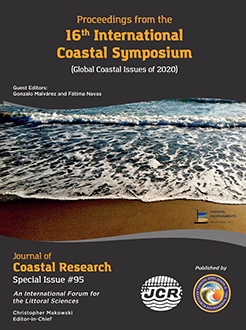Passarella, M.; Ruju, A.; De Muro, S., and Coco, G., 2020. Horizontal runup and seagrass beach cast-litters: Modelling and observations. In: Malvárez, G. and Navas, F. (eds.), Global Coastal Issues of 2020. Journal of Coastal Research, Special Issue No. 95, pp. 143-147. Coconut Creek (Florida), ISSN 0749-0208.
We collected measurements of wave-driven swash on a beach characterized by the presence and accumulation of seagrass beach-cast litter (the so-called banquette). Beach surveys showed that this deposit can drastically steepen the foreshore thus affecting wave dynamics. This work explores the relationship between vertical and horizontal swash time series, in a previously unreported case of seagrass wrack deposits under mild to moderate incoming waves. The results from the field measurements, obtained by video imagery time stack analysis, show that the seagrass deposits influence wave runup. The horizontal runup extent can be reduced when compared with a nearby “seagrassfree” profile under the same incoming waves. The horizontal runup in case of seagrass presence seems to be approximately one-third of the seagrass absence case. The ratio between observed vertical and horizontal swash, when seagrass deposits are present, is almost 3.5 times the seagrassfree case. The SWASH model was used to extend the analysis beyond our field observations. A number of possible wave forcing scenarios were run on both the seagrass-rich and the seagrass-free profiles. Differences between the cases of seagrass presence and absence show that the horizontal wave runup in case of seagrass deposition can be largely reduced. Using observations and modelling, we show that the seagrass deposits on the beach face and berm inhibit the horizontal runup and so affect one of the key components necessary to predict coastal inundation and to manage coastal areas especially considering ongoing changes in the mean sea level.





